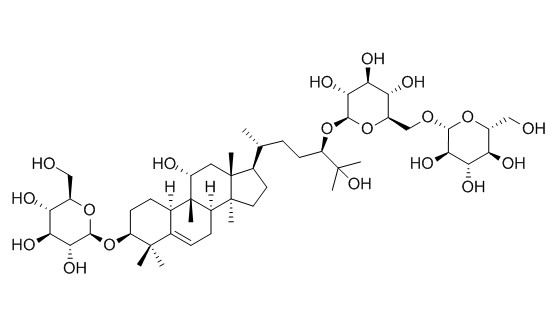Mogroside III
The human intestinal bacteria shows potent ability to transform Mogroside III to release secondary glycoside mogroside II(A1) and aglycone mogrol.
Inquire / Order:
manager@chemfaces.com
Technical Inquiries:
service@chemfaces.com
Tel:
+86-27-84237783
Fax:
+86-27-84254680
Address:
1 Building, No. 83, CheCheng Rd., Wuhan Economic and Technological Development Zone, Wuhan, Hubei 430056, PRC
Providing storage is as stated on the product vial and the vial is kept tightly sealed, the product can be stored for up to
24 months(2-8C).
Wherever possible, you should prepare and use solutions on the same day. However, if you need to make up stock solutions in advance, we recommend that you store the solution as aliquots in tightly sealed vials at -20C. Generally, these will be useable for up to two weeks. Before use, and prior to opening the vial we recommend that you allow your product to equilibrate to room temperature for at least 1 hour.
Need more advice on solubility, usage and handling? Please email to: service@chemfaces.com
The packaging of the product may have turned upside down during transportation, resulting in the natural compounds adhering to the neck or cap of the vial. take the vial out of its packaging and gently shake to let the compounds fall to the bottom of the vial. for liquid products, centrifuge at 200-500 RPM to gather the liquid at the bottom of the vial. try to avoid loss or contamination during handling.
Molecules.2024, 29(3):671.
Nutr Res Pract.2020, 14(5):478-489.
Heliyon.2024, 10(12):e31722.
Antimicrob Agents Chemother.2024, e0031424.
BMC Pharmacol Toxicol.2018, 19(1):5
J Pharm Biomed Anal.2021, 196:113931.
International Food Research Journal2018, 25(6):2560-2571
Arch Toxicol.2017, 91(10):3225-3245
J Nat Prod.2022, 85(5):1351-1362.
Biomedicines.2022, 10(5):1170
Related and Featured Products
Se Pu. 2008 Jul;26(4):504-8.
Simultaneous determination of six cucurbitane triterpene glycosides in Siraitia grosvenorii fruits using high performance liqid chromatography.[Pubmed:
18959251]
Siraitia grosvenorii, a traditional Chinese fruit, belongs to the family Cucurbitaceae and has been used as a pulmonary demulcent and emollient for the treatment of dry cough, sore throat, dire thirst, and constipation in folk medicine.
METHODS AND RESULTS:
A high performance liquid chromatographic method was developed for simultaneous determining the contents of mogroside V, mogroside IV A, Mogroside III, 11-oxoMogroside III, mogroside II E and 11-oxomogroside II E in Siraitia grosvenorii fruits. The chromatographic analysis was carried out on a ZORBAX SB-C18 column (150 mm x 4.6 mm, 5 microm). The mobile phase was water (A) and acetonitrile (B) with gradient elution (0-3 min, 20% B - 30% B; 3-8 min, 30% B - 35% B; 8-9 min, 35% B). The flow rate was maintained at 0. 8 mL/min. The detection wavelength was set at 203 nm and the column temperature was controlled at 30 degrees C. The sample injection volume was 10 microL. The calibration curves were linear over the ranges of 0.04 - 1.0 mg/mL, 0.011 - 0.68 mg/mL, 0.010 - 0.80 mg/mL, 0.0097 - 0.58 mg/mL, 0.025 - 1.0 mg/mL and 0.013 - 0.76 mg/mL (r > 0.999 1) for the above cucurbitane triterpene glycosides, respectively. The average recoveries were 99. 65% for mogroside V , 101.6% for mogroside IV A, 97. 05% for mogroside m, 103. 1% for 11-oxomogroside I, 99. 25% for mogroside II E, and 103.0% for 11-oxomogroside II E, with the relative standard deviations of 0.83%, 3.1%, 1.9%, 3.3%, 0.59% and 2.0%, respectively.
CONCLUSIONS:
This simple, rapid and accurate method is suitable for quality control and determination of raw materials and products of Siraitia grosvenorii fruits.
Beijing Da Xue Xue Bao. 2007 Dec 18;39(6):657-62.
Biotransformation of mogroside III by human intestinal bacteria.[Pubmed:
18087563]
To investigate the biotransformation of Mogroside III, one of the main chemical constituent in the fruits of Momordica grosvenori Swingle, by the crude enzymes of human intestinal bacteria, and determine the structure of biotransformation products and provide scientific basis for absorption evaluation of primary Mogroside III in human intestine.
METHODS AND RESULTS:
The Mogroside III was incubated with crude enzymes of human intestinal bacteria under the anaerobic environment and 37 degrees C condition to transform Mogroside III. The biotransformation products were isolated and purified by silica gel column chromatography, and structurally determined by infra-red (IR) and nuclear magnetic resonance (NMR) spectrometry and mass spectroscopy (MS) techniques. Mogroside III was converted to mogroside II(A1) and mogrol by successive deglycosylation at C-3 of the glucosyl group and C-24 of the gentiobiosyl group.
CONCLUSIONS:
The human intestinal bacteria showed potent ability to transform Mogroside III to release secondary glycoside mogroside II(A1) and aglycone mogrol.



